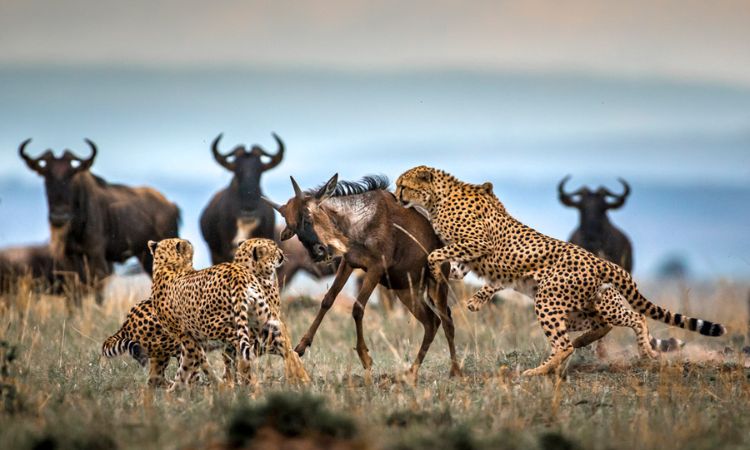Embark on a breathtaking journey through three of Kenya’s iconic safari destinations: Masai Mara, Tsavo National Park, and Amboseli National Park. This guide explores the best times to experience the majestic wildlife and stunning landscapes of each park, providing a comprehensive itinerary for those seeking adventure and memorable encounters with nature.
Choosing the Perfect Time for Your Safari Adventure
Choosing the Perfect Time for Your Safari Adventure: Explore the optimal seasons for embarking on safari trips in Kenya, focusing on weather patterns and wildlife behaviors in Masai Mara, Tsavo National Park, and Amboseli National Park. Explain how the Great Migration in Masai Mara and Amboseli’s dry season impact viewing opportunities, ensuring travelers experience peak wildlife action during their visits. Discuss climate considerations and how they influence travel plans, maximizing the safari experience.
Exploring the Iconic Masai Mara
Exploring the iconic Masai Mara is an immersion into a primeval nexus of life where the drama of survival unfolds on the vast savannah grasslands. The Masai Mara, part of the larger Serengeti ecosystem, is heralded for the Great Migration, an annual spectacle wherein millions of wildebeest, along with zebra and Thomson’s gazelle, navigate perilous river crossings and predator-laden landscapes in their quest for fresh pastures. This mass movement, typically peaking between July and October, turns the Mara into a bustling hub of activity, offering unparalleled scenes of natural drama.
The significance of the Maasai culture to the Mara cannot be overstated, casting a light on the symbiotic relationship between the land and its ancestral custodians. The Maasai, known for their distinctive customs and attire, have grazed their cattle across these plains for centuries, living in harmony with the wild inhabitants of this ecosystem. Visitors oftentimes have the opportunity to engage with Maasai communities, gaining insight into their traditions and the conservation efforts that are pivotal in maintaining the balance between human habitation and wildlife preservation.
Conservation efforts within the Masai Mara are vital in protecting its rich biodiversity. These include anti-poaching patrols, community outreach programs, and habitat restoration projects, all aimed at ensuring the survival of the park’s incredible wildlife, such as lions, elephants, and leopards, in their natural habitats.
Throughout the year, the Mara provides habitat to a diverse array of species, making every visit a unique encounter with the wild. Outside the migration months, the reserve remains a vibrant ecosystem, teeming with predators and their prey in an eternal dance of life and death. The landscape itself, with its rolling grasslands, riverine forests, and acacia trees, offers a picturesque backdrop to the abundant wildlife. For those keen on experiencing the raw essence of Africa, the Masai Mara offers a window into an untamed world where nature’s law reigns supreme, making it a year-round destination for safari enthusiasts seeking to connect with the heart of the wilderness.
Captivating Landscapes and Wildlife of Tsavo and Amboseli
Transitioning from the iconic plains of the Masai Mara National Park, our safari journey leads us to the contrasting landscapes of Tsavo National Park and Amboseli National Park. Divided into Tsavo East and Tsavo West, Tsavo is a massive, biodiverse wilderness spanning both arid plains and dense forests, interspersed with volcanic hills and a network of rivers. Tsavo East is famed for its vast herds of dust-red elephants that roam beneath the shadow of the Yatta Plateau, while Tsavo West offers a more varied topography including the Mzima Springs, a series of natural pools fed by underground rivers from Mount Kilimanjaro, providing an oasis for the park’s wildlife and a unique spot for visitors hoping to glimpse hippos and crocodiles. The rugged wilderness of Tsavo, coupled with its historical significance as the domain of the famed man-eating lions, adds a mystic layer to the safari experience unparalleled in other areas.
Contrastingly, Amboseli National Park presents an entirely different panorama. The park is globally renowned for its thriving elephant population, where families of these majestic creatures can be observed against the stunning backdrop of Mount Kilimanjaro. The contrast between the arid areas dominated by acacia trees and the lush wetlands makes it a haven for photographers aiming to capture the essence of Africa’s raw beauty. Amboseli’s diverse ecosystems, including the salt pans and savannas, support a rich array of wildlife, including cheetahs, lions, buffaloes, and a multitude of bird species, offering an in-depth look into the vibrant life cycles and natural habitats of these creatures.
Each park’s unique attributes cater to different safari experiences. Tsavo with its vast wilderness areas offers a sense of solitude and adventure, appealing to those wishing to explore the wild in its most untamed form. On the other hand, Amboseli is often celebrated for its more accessible wildlife viewing opportunities, especially of the elephants against the picturesque Kilimanjaro, a scene that has graced countless magazines and documentaries, symbolizing the quintessential African landscape. The proximity to this snow-capped giant also allows for cooler climates, making safaris a pleasant experience year-round and providing a striking contrast from the thermal flatlands of Tsavo.
Both parks indeed offer rich, distinctive safari ventures that are as diverse in experiences as they are in their landscapes and wildlife spectacles. Whether it is the rugged terrains of Tsavo or the marshy plains of Amboseli, visitors are guaranteed unforgettable encounters with Africa’s majestic fauna, set against some of the continent’s most breathtaking backdrops.
Conclusions
In conclusion, choosing the right time for your safari can greatly enhance your experience. The seasonal variations in Masai Mara, Tsavo, and Amboseli shape the wildlife encounters and scenic views. By understanding these dynamics, travelers can plan their trips to align with peak events and ideal climatic conditions, ensuring an authentic and rewarding safari adventure.




